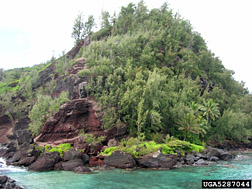This page has been archived and is being provided for reference purposes only. The page is no longer being updated, and therefore, links on the page may be invalid.
|
Read the magazine story to find out more. |
|
|
|
|
ARS Researchers Search for Casuarina Biological Control Agents
By Alfredo FloresSeptember 2 , 2008
Australia's Outback and remote coastlines are home to insects that could be key biocontrols for a highly invasive weed threatening coastal areas of the United States, according to Agricultural Research Service (ARS) scientists and cooperators.
ARS entomologist Greg Wheeler and his ARS and university colleagues are touring the Outback and Australia's coastal areas in search of biological control agents for the highly invasive Casuarina species commonly called Australian pine.
This weed is infiltrating U.S. coastal areas, especially in south Florida, the Virgin Islands, Puerto Rico and Hawaii. Known for its rapid growth and dense coverage, Australian pine inhibits the growth of native plants.
The Australian pine problem includes three Casuarina species--C. equisetifolia (referred to in Australia as “coastal she-oak”), C. glauca (“swamp she-oak,” and arguably as big or a bigger problem than C. equisetifolia) and C. cunninghamiana (“river she-oak”).
In the past few years, the Australian members of the team--Matthew Purcell and Bradley Brown, researchers at the ARS Australian Biological Control Laboratory in Indooroopilly, Queensland, and Gary Taylor from the University of Adelaide, Australia--conducted five separate trips throughout Australia. Purcell, Brown, Taylor and John Gaskin, research leader of the ARS Pest Management Research Unit in Sidney, Mont., collectively comprise a Casuarina research team.
Wheeler served as the lead scientist for the project, coordinating the funding, surveys and plant-DNA testing. From a bounty of some 300 wasps, weevils, stem-borers, sap-suckers, seed-eaters and more, the scientists have narrowed the field of potential control agents to about 12 candidates.
Not only do these top candidates attack C. equisetifolia, but many also attack C. glauca and C. cunninghamiana. Among the top finds were the seed-feeding wasp Bootanelleus orientalis, which is host-specific to Australian pine, and the defoliator moth Zauclophora pelodes.
These insects are still undergoing testing by Purcell and colleagues in Australia to determine their suitability for use as biological control agents in the United States. Insects that decrease Casuarina reproduction and spread are being given the most attention.
Read more about the research in the September 2008 issue of Agricultural Research magazine.
ARS is a scientific research agency of the U.S. Department of Agriculture.

